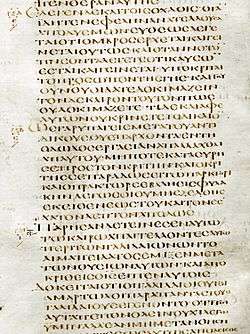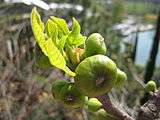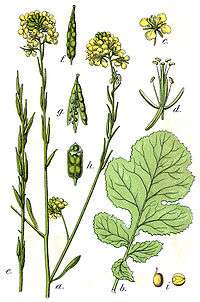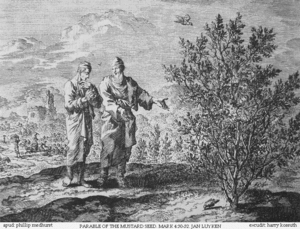Luke 13
| Luke 13 | |
|---|---|
|
Luke 6:4-16 on Papyrus 4, written about AD 150-175. | |
| Book | Gospel of Luke |
| Bible part | New Testament |
| Order in the Bible part | 3 |
| Category | Gospel |
Luke 13 is the thirteenth chapter of the Gospel of Luke in the New Testament of the Christian Bible. It records several parables and teachings told by Jesus Christ and His lamentation over the city of Jerusalem.[1] The book containing this chapter is anonymous but early Christian tradition uniformly affirmed that Luke composed this Gospel as well as Acts.[2]
Text

- The original text is written in Koine Greek.
- Some most ancient manuscripts containing this chapter are:
- Papyrus 75 (written about AD 175-225)
- Papyrus 45 (ca. AD 250)
- Codex Vaticanus (AD 325-350)
- Codex Sinaiticus (AD 330-360)
- Codex Bezae (ca. AD 400)
- Codex Washingtonianus (ca. AD 400)
- Codex Alexandrinus (ca. AD 400-440)
- This chapter is divided into 35 verses.
Structure
This chapter can be grouped (with cross references to other parts of the Bible):
- Luke 13:1-5 = Repent or Perish
- Luke 13:6-9 = The Parable of the Barren Fig Tree
- Luke 13:10-17 = A Spirit of Infirmity
- Luke 13:18-19 = The Parable of the Mustard Seed (Matthew 13:31-32; Mark 4:30-32)
- Luke 13:20-21 = The Parable of the Leaven (Matthew 13:33-35)
- Luke 13:22-33 = The Narrow Way
- Luke 13:34-35 = Jesus Laments over Jerusalem (Matthew 23:37-39; Luke 19:41)
Parable of the barren fig tree


This parable of Jesus (not to be confused with the parable of the budding fig tree) appears only in the Gospel of Luke among the Canonical gospels of the New Testament. In this parable, the owner is generally regarded as representing God, who had a fig tree ("tree of knowledge") planted in his vineyard ("the garden of Eden") and came seeking fruit ("righteous works", which in part is a mystery). The gardener (vinedresser) is God and the vine is Jesus ("tree of Life").[3] Fig trees were often planted in vineyards.[4] The fig tree was a common symbol for Israel, and may also have that meaning here,[3] or the tree in the parable may refer to the religious leadership.[4] In either case, the parable reflects Jesus offering his hearers one last chance for repentance.[4] "These three years" logically refers to the period of Jesus' ministry. The parable has been connected to the miracle of cursing the fig tree. Richard Whately commented that this parable "is one which our Lord may be said to have put before his hearers twice; once in words, once in action."[5]
Although the parable is found only in Luke's gospel, there is no strong argument against authenticity, even a majority of the members of the Jesus Seminar voted it authentic.[4]
Parable of the Mustard Seed


This parable is one of the shorter parables of Jesus. It appears in three of the Canonical gospels of the New Testament. The differences between Gospels of Matthew (13:31–32), Mark (4:30–32), and Luke (13:18–19), are minor. In the Gospels of Matthew and Luke, it is immediately followed by the Parable of the Leaven, which shares this parable's theme of the Kingdom of Heaven growing from small beginnings.
A version of the parable also occurs in the non-canonical Gospel of Thomas 20.[6]
The plant referred to here is generally considered to be black mustard, a large annual plant up to 9 feet (2.7 m) tall,[7] but growing from a proverbially small seed[7] (this smallness is also used to refer to faith in Matthew 17:20 and Luke 17:6). According to rabbinical sources, Jews did not grow the plant in gardens,[7] and this is consistent with Matthew's description of it growing in a field. Luke tells the parable with the plant in a garden instead; this is presumably recasting the story for an audience outside Palestine.[7]
Parable of the Leaven

The Parable of the Leaven (also called the Parable of the yeast) is one of the shorter parables of Jesus. It appears in two of the Canonical gospels of the New Testament. The differences between Gospels of Matthew (Matthew 13:33) and Luke (Luke 13:20–21) are minor. In both places it immediately follows the Parable of the Mustard Seed, which shares this parable's theme of the Kingdom of Heaven growing from small beginnings.
A version of the parable also occurs in the non-canonical Gospel of Thomas (96[6]).
See also
- Sermon on the Mount
- Sermon on the Plain
- Ministry of Jesus
- Parables of Jesus
- Other related Bible parts: Matthew 13, 23; Mark 4; Luke 19
References
- ↑ Halley, Henry H. Halley's Bible Handbook: an abbreviated Bible commentary. 23rd edition. Zondervan Publishing House. 1962.
- ↑ Holman Illustrated Bible Handbook. Holman Bible Publishers, Nashville, Tennessee. 2012.
- 1 2 Timothy Maurice Pianzin, Parables of Jesus: In the Light of Its Historical, Geographical & Socio-Cultural Setting, Tate Publishing, 2008, ISBN 1-60247-923-2, pp. 235-237.
- 1 2 3 4 Peter Rhea Jones, Studying the Parables of Jesus, Smyth & Helwys, 1999, ISBN 1-57312-167-3, pp. 123-133.
- ↑ Richard Whately, Lectures on Some of the Scripture Parables, John W. Parker and Son, 1859, p. 153.
- 1 2 Gospel of Thomas: Lamb translation and Patterson/Meyer translation.
- 1 2 3 4 I. Howard Marshall, The Gospel of Luke: A commentary on the Greek text, Eerdmans, 1978, ISBN 0-8028-3512-0, pp. 561.
External links
| Preceded by Luke 12 |
Chapters of the Bible Gospel of Luke |
Succeeded by Luke 14 |
.jpg)